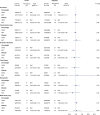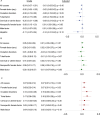Overweight or obesity in children born after assisted reproductive technologies in Denmark: A population-based cohort study
- PMID: 38113196
- PMCID: PMC10729995
- DOI: 10.1371/journal.pmed.1004324
Overweight or obesity in children born after assisted reproductive technologies in Denmark: A population-based cohort study
Abstract
Background: The association between assisted reproductive technologies (ARTs) and the body mass index (BMI) of children remains controversial. Confounding by morbidity and other factors associated with parental infertility may have biased studies comparing children born after ART with children born after no treatment. We investigated the associations between different fertility treatments and BMI in children at age 5 to 8 years, adjusting for and stratifying by causes of parental infertility.
Methods and findings: This Danish cohort study included 327,301 children born between 2007 and 2012 (51% males, median age at follow-up 7 years). Of these, 13,675 were born after ART, 7,728 were born after ovulation induction with or without intrauterine insemination [OI/IUI], and 305,898 were born after no fertility treatments. Using the International Obesity Task Force (IOTF) standards, we defined overweight (BMI ≥ IOTF-25) and obesity (BMI ≥ IOTF-30). We compared children born after ART versus OI/IUI; intracytoplasmic sperm injection (ICSI) versus conventional in vitro fertilization (IVF); and frozen-thawed versus fresh embryo transfer and estimated crude and adjusted prevalences of children with overweight or obesity at age 5 to 8 years, prevalence odds ratios (PORs), and differences in mean BMI z-scores. Adjustment was performed using stabilized inverse probability of treatment weights, including parity, year of conception, parental causes of infertility, age, educational level, comorbidities, maternal country of origin, BMI, and smoking as covariates. The crude prevalence of obesity was 1.9% in children born after ART, 2.0% in those born after OI/IUI, and 2.7% in those born after no fertility treatment. After adjustment, children born after ART and OI/IUI had the same prevalence of being overweight (11%; POR 1.00, 95% confidence interval [CI] 0.91 to 1.11; p = 0.95) or obese (1.9%; POR 1.01, 95% CI 0.79 to 1.29; p = 0.94). Comparison of ICSI with conventional IVF yielded similar pattern (POR 0.95, 95% CI 0.83 to 1.07; p = 0.39 for overweight and POR 1.16, 95% CI 0.84 to 1.61; p = 0.36 for obesity). Obesity was more prevalent after frozen-thawed (2.7%) than fresh embryo transfer (1.8%) (POR 1.54, 95% CI 1.09 to 2.17; p = 0.01). The associations between fertility treatments and BMI were only modestly different in subgroups defined by the cause of infertility. Study limitations include potential residual confounding, restriction to live births, and lack of detailed technical information about the IVF procedures.
Conclusions: We found no association with BMI at age 5 to 8 years when comparing ART versus OI/IUI or when comparing ICSI versus conventional IVF. However, use of frozen-thawed embryo transfer was associated with a 1.5-fold increased risk of obesity compared to fresh embryo transfer. Despite an elevated relative risk, the absolute risk difference was low.
Copyright: © 2023 Laugesen et al. This is an open access article distributed under the terms of the Creative Commons Attribution License, which permits unrestricted use, distribution, and reproduction in any medium, provided the original author and source are credited.
Conflict of interest statement
The authors have declared that no competing interests exist.
Figures





References
-
- European IVF-Monitoring Consortium (EIM) for the European Society of Human Reproduction and Embryology (ESHRE), Wyns C, De Geyter C, Calhaz-Jorge C, Kupka MS, et al.. ART in Europe, 2017: results generated from European registries by ESHRE†. Hum Reprod Open. 2021;2021(3). doi: 10.1093/hropen/hoab026 - DOI - PMC - PubMed
-
- The World Health Organization. Infertility is a global public health issue [cited 2022 Mar 1]. Available from: https://www.who.int/reproductivehealth/topics/infertility/perspective/en/.
-
- Ceelen M, van Weissenbruch MM, Roos JC, Vermeiden JP, van Leeuwen FE, Delemarre-van de Waal HA. Body composition in children and adolescents born after in vitro fertilization or spontaneous conception. J Clin Endocrinol Metab. 2007;92(9):3417–3423. Epub 2007/06/28. doi: 10.1210/jc.2006-2896 . - DOI - PubMed

